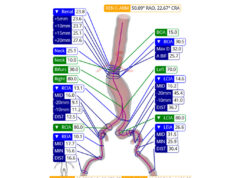
Results from the Central blood pressure and variability evaluation in abdominal aortic aneurysm (AAA), or CAVE-ON, study, which sought to measure the impact of blood pressure control on AAA growth rates, found no significant association between growth and central blood pressure variability.
The data were delivered as a podium-first during a CX abdominal aortic challenges session on Thursday afternoon.
The prospective longitudinal investigation additionally detected no significant association between AAA growth and mean peripheral or central blood pressure, no significant association between time to intervention/rupture and any of the blood pressure measures, and no association between AAA growth and medication adherence, presenting author Colin Bicknell (London, United Kingdom) told CX.
CAVE-ON grew out the AARDVAARK randomised controlled trial in 2016, which examined the influence of an ACE inhibitor on AAA growth and found no effect, Bicknell explained. That then led to the AARDVARK-CAVE (Central BP augmentation index and blood pressure variability evaluation) sub-study, which showed no association for mean central blood pressure but also did suggest a “significant association” between central blood pressure variability and AAA growth after adjustment for possible confounders.
“Interestingly, this theory is plausible because blood pressure variability and episodic hypertension are both very important predictors of future cardiovascular events and mortality,” Bicknell said.
To sort through these results, Bicknell and colleagues sought to design a definitive study, which yielded CAVE-ON. This meant double the numbers included in the AARDVARK-CAVE study—137 subjects were recruited—and wider inclusion criteria in terms of the patient pool’s aneurysm size.
Excluded were those with connective tissue disease and atrial fibrillation. The patients included were scanned every four months over a period up to two years and growth was estimated by a mixed-effects model. Blood pressure variability was measured by three standardized methods. The growth rate was 1.3mm per year. Antihypertensive adherence was recorded as 75%.
The study further demonstrated current smoking was associated with faster growth, Bicknell noted, saying that “what is interesting about this study is that those patients diagnosed with ischaemic heart disease were associated with a slower growth rate.”
He continued: “When we looked into these patients, there were some differences between these groups: they were prescribed more rounds of hypertensives, they had lower blood pressure and more rounds of antiplatelets, and yet they were similar throughout all of the other characteristics.”
Bicknell said he could therefore “hopefully put to bed” a direct association between blood pressure measures and AAA growth. “There was a reduced growth in the presence of ischaemic heart disease diagnosis, and it seems to be attributable to better prescription of cardiovascular medication,” he added. “My take home message is that best medical therapy [BMT] may have a most important role in limiting aneurysm growth, underling the importance of this in every aneurysm screening patient.”
The study was carried out with Ed Charles, Bicknell’s PhD student, in collaboration with the late Janet Powell, as well as Neil Poulter and Emanuela Falaschetti.













